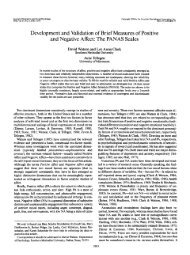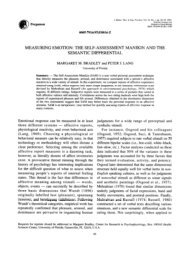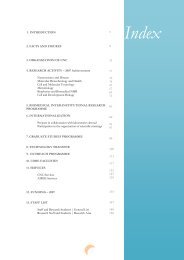Annual Report of Activities CNC 2008 - Center for Neuroscience and ...
Annual Report of Activities CNC 2008 - Center for Neuroscience and ...
Annual Report of Activities CNC 2008 - Center for Neuroscience and ...
Create successful ePaper yourself
Turn your PDF publications into a flip-book with our unique Google optimized e-Paper software.
Future PlansThere is an enormous wealth <strong>of</strong> expertise in terms <strong>of</strong> healthcare, medical know‐how; sample collections<strong>and</strong> patient groups at HUC/FMUC, which could be explored further, provided there are common interests<strong>and</strong> the partnerships are mutually potentiating. However the <strong>CNC</strong> should conduct organized prospectingin terms <strong>of</strong> novel possibilities <strong>for</strong> clinical research.The “pitfalls” <strong>of</strong> the approach include encroachment <strong>of</strong> both clinical <strong>and</strong> research perspectives (i.e.“territorial” issues), which must be made to dialogue with vocabularies that are not exactly the same,although they may sound similar. An important point is that value‐frames <strong>and</strong> time‐frames also aredifferent, from day‐to‐day clinical care, to long‐term research approaches. It is thus crucial to identifywilling partners on both sides, <strong>and</strong> nurture the dialogue continuously. It can be done.Some examples <strong>of</strong> possible joint approaches are:‐ Using Induced Pluripotency to create Stem‐cell‐like cells from patients with different pathologies, thusenabling the creation <strong>of</strong> human cell line models on which the disease can be modeled, <strong>for</strong> drug <strong>and</strong> geneexpression screens, etc.‐ Tissue engineering <strong>for</strong> tissue repair in cardiology or other specialties.‐ The development <strong>of</strong> new animal models <strong>for</strong> specific diseases <strong>of</strong> interest (e.g. transgenic rats or mice).‐ Development <strong>of</strong> trans‐services core facilities (microscopy, flow cytometry, sequencing, gene expression,etc) that are not involved in day‐to‐day operations <strong>and</strong> are there<strong>for</strong>e available <strong>for</strong> research purposes.The groups in the “Cell <strong>and</strong> Development Biology” area will continue to develop the research lines inwhich they are engaged, further strengthening existing collaborations <strong>and</strong> seeking new ones, both national<strong>and</strong> international. In terms <strong>of</strong> funding, all groups will continue to apply <strong>for</strong> grants from FCT <strong>and</strong> othernational <strong>and</strong> international institutions.76






